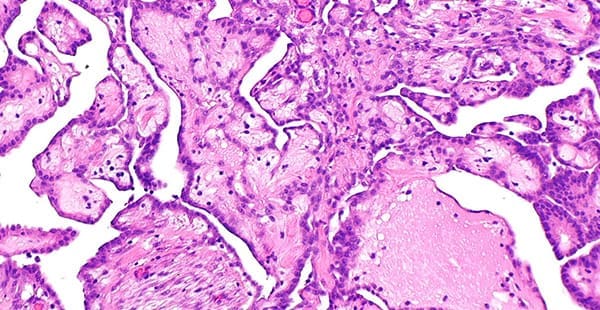Rare Types of Epithelioid Mesothelioma
Epithelial cells make up around 70 – 80% of mesothelioma cases and demonstrate a better mesothelioma prognosis than sarcomatoid cells. These cells are found in many different shapes, but often appear round or oblong, sometimes with multiple nuclei. The defining characteristic of epithelioid cells is how they group together, forming clusters with slow metastasis.
Epithelial mesothelioma has four main rare cell types, including adenomatoid, cystic, deciduoid and papillary. With limited data, there is no standard of care for each type, though there are treatments that have been effective in cases that have emerged, including surgery, chemotherapy, radiation or a combination of these treatments (multimodal therapy).
Adenomatoid Mesothelioma
Adenomatoid mesothelioma, also referred to as glandular mesothelioma or microglandular mesothelioma, can be classified as benign or malignant. Adenomatoid cells line small, gland-like structures, and are usually found in the genital glands of both men and women. A limited number of cases have shown a life expectancy of 10 years.
- Location: Small, gland-like structures, usually genital glands
- Cell appearance: Flat or cube-shaped
- Metastasis: Lace-like growth patterns and potential for distant metastasis
- Treatment: Surgery (benign) or multimodal treatment (malignant)
Cystic Mesothelioma
Cystic mesothelioma occurs in the form of cysts and has a better prognosis than most cases of mesothelioma as it largely develops as benign. One study noted more than half of reported patients have experienced recurrence with a progression-free survival rate of 72%. However, other studies have shown potential for malignant transformation and malignant recurrence, which could negatively impact survival. This type of cancer is most common in women of reproductive age.
- Location: Peritoneum (most common) or other pelvic structures like the omentum, uterus, bladder, and rectum (less common)
- Cell appearance: Flat or cube-shaped cells, making smooth, thin-walled cysts connected by delicate fibrovascular tissues
- Metastasis: Localized with no spreading
- Treatment: Surgery
Deciduoid Mesothelioma
Deciduoid mesothelioma is extremely rare, very unique, and has only been diagnosed in a small number of cases. It typically arises in the peritoneum. Deciduoid mesothelioma has in general been associated with a poor prognosis of about five or six months. The cause of this form of mesothelioma is unknown, though some doctors feel that it’s caused by a hormonal imbalance and others suspect a correlation with asbestos exposure.
- Location: Peritoneum (most common), pleura
- Cell appearance: Large, polygonal or oval-shaped cells that form tumors made up of firm white or gray nodules
- Metastasis: Typically spreads and progresses, even with treatment
- Treatment: Multimodal treatment and/or palliative treatment
Papillary Mesothelioma
Papillary mesothelioma, also known as well-differentiated papillary mesothelioma (WDPM), is most common in women of reproductive ages, though men have also been diagnosed. Prognosis is typically favorable, as most cases are benign. One study notes a 10-year survival rate of 30.8%.
- Location: Abdominal linings (peritoneum), tunica vaginalis, lung linings (pleura), areas of the male reproductive system
- Cell appearance: Resemblance to normal, healthy cells
- Metastasis: Slow, microscopic growth pattern that creates small projects that resemble fingers (papillae)
- Treatment: Surgery (benign) or multimodal treatment (malignant)
Rare Types of Sarcomatoid Mesothelioma
Sarcomatoid mesothelioma is much harder to diagnose than epithelial as sarcomatoid cells strongly resemble healthy tissue. These types of cancer cells are aggressive and grow quickly, limiting treatment options and resulting in poor survival rates for patients affected. Sarcomatoid mesothelioma has three main rare subtypes, including desmoplastic, lymphohistiocytoid and transitional mesothelioma.
Desmoplastic Mesothelioma
Most desmoplastic mesothelioma tumors are composed of sarcomatoid cells, though some epithelial and biphasic cases have emerged. At least 50% of desmoplastic tumors are composed of dense, fibrous tissue. Accumulated cases have shown an average life expectancy of 3.8 months.
- Location: Abdominal linings (peritoneum), tunica vaginalis, lung linings (pleura), areas of the male reproductive system
- Cell appearance: Patternless
- Metastasis: Can spread to the lung or chest wall, though cancerous tissues look vastly similar to benign fibrous tissue
- Treatment: Radiation or chemotherapy and pleurodesis or paracentesis
Lymphohistiocytoid Mesothelioma
Making up less than 1% of all mesothelioma diagnoses, most cases of lymphohistiocytoid mesothelioma are sarcomatoid, though researchers have noted a few cases of biphasic tumors. These tumors are composed of dense bundles of inflammatory immune cells, closely resembling other conditions. This cancer is commonly misdiagnosed as non-Hodgkin’s lymphoma, lymphoepithelial carcinoma, sarcomatoid carcinoma of the lung and ganglioneuroma.
- Location: Abdomen, linings of the lung (pleural)
- Cell appearance: Large, polygonal, spindle-shaped histiocytoid cells, mixed with lymphocytes (white blood cells)
- Metastasis: Tumors can spread to other regions of the body, potential for recurrence after surgical removal
- Treatment: Multimodal treatment
Transitional Mesothelioma
Transitional mesothelioma is difficult to diagnose due to cell structure. These tumors are extremely rare, with only a few case reports referencing the subtype. Studies have noted life expectancies of less than one year.
- Location: Pleura or peritoneum (most common), pericardium (less common)
- Cell appearance: Spindle-shaped, sometimes resembling healthy epithelioid cells
- Metastasis: Aggressive with high potential to metastasize
- Treatment: Surgery, chemotherapy and/or radiation
Other Rare Types of Mesothelioma
Some mesothelioma cancer subtypes cannot be definitively classified as epithelial, sarcomatoid or biphasic, including heterologous mesothelioma, small cell mesothelioma and localized fibrous tumors. The rarest of all rare types, treatment and prognosis for these cases are largely unknown, leading physicians to rely on standard malignant mesothelioma treatment plans.
Heterologous Mesothelioma
Heterologous tumors are recognized by the presence of bodily tissues from other areas of the body, including bone, cartilage, and soft tissues. One study looking at 27 patients saw an average survival of six months.
- Location: Pleural cavity, peritoneal cavity, or pericardial cavity
- Cell appearance: Varies
- Metastasis: Unknown with varied cases
- Treatment: Chemotherapy or radiation and pleurodesis or paracentesis
Common heterologous elements include osteosarcomatous and chondrosarcomatous. Such cases are labeled as tumors with osteosarcomatous differentiation or chondrosarcomatous differentiation in studies.
Osteosarcomatous Differentiation
Osteosarcomatous differentiation is a type of heterologous mesothelioma. In some cases of malignant pleural mesothelioma, osteosarcomatous differentiation has been recorded. Exceedingly rare, there is not much data for this type of mesothelioma, however, it’s classified by the presence of bone cells within the tumors.
Chondrosarcomatous Differentiation
Chondrosarcomatous differentiation is a type of heterologous mesothelioma, recognized by the presence of spindle-shaped cells from cartilage.
Localized Fibrous Tumors
Also referred to as benign fibrous mesothelioma, localized fibrous tumors (LFT) have been seen in both men and women. Case reports have found that about half of patients experience symptoms, while half are asymptomatic. Typically classified as sarcomatoid, patients usually see a life expectancy of less than one year.
- Location: Pleura (most common), pericardium, tunica vaginalis or peritoneum (less common)
- Cell appearance: Spindle-shaped
- Metastasis: Typically localized with potential for recurrence
- Treatment: Multimodal treatment
Small Cell Mesothelioma
Small cell mesothelioma is also frequently misdiagnosed. Only seen in a few cases, mesothelioma specialists typically rely on their knowledge of common types of mesothelioma to determine their treatment approach. In a study of eight cases, average survival was 8.2 months.
- Location: Pleural cavity, peritoneal cavity, or pericardial cavity
- Cell appearance: Mostly small cells
- Metastasis: Growth patterns very similar to those of small cell carcinoma, but without stream-like, ribbon, or rosette appearances
- Treatment: Varies
Diagnosing Rare Forms of Mesothelioma
Diagnosis of rare types of mesothelioma is the same as common types. Examination of mesothelioma symptoms, imaging scans and biopsies are performed to pinpoint the disease, with tissue biopsies being the determining factor of malignancy and cancer type. In some cases, multiple biopsies may be necessary to figure out the exact type, since some tumors are composed of different types of tissues. A pathologist experienced in mesothelioma diagnoses is needed to ensure the correct diagnosis.
Mesothelioma Histology
Histology, the study of cellular anatomy, has been a large component in understanding different mesothelioma cell types and determining the best paths for treatment. A pathologist will first collect a tissue sample, which will be preserved and embedded, making them easy to cut and segment. After sectioning, tissues are mounted and stained for a detailed view into cell structure. In addition to traditional histology methods, immunohistology is frequently used in mesothelioma diagnoses, utilizing antibodies to detect and identify specific proteins that can differentiate mesothelioma from other cancers.
An accurate diagnosis is needed to determine prognosis and treatment for the patient, which can be challenging for rare types of mesothelioma. With more research and emerging cases, mesothelioma specialists can hopefully make advances in treatment options and efforts towards finding a cure.











